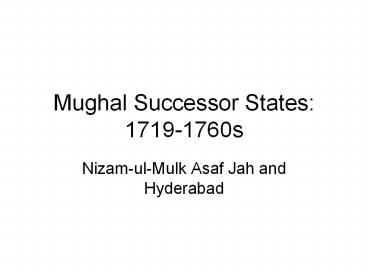Mughal Successor States: 1719-1760s PowerPoint PPT Presentation
1 / 19
Title: Mughal Successor States: 1719-1760s
1
Mughal Successor States 1719-1760s
- Nizam-ul-Mulk Asaf Jah and Hyderabad
2
The Nawabs and the their states
- nawab comes from the Persian naib, which means
deputy. - Although the Nawbas of Bengal, Awadh, and
Hyderabad were independent from the Mughal
Emperor by the mid-18th c. the fiction of Mughal
supremacy was preserved - The khutba continued to be read in the Mughal
Emperors name, and coins struck in his name as
well.
3
(No Transcript)
4
Hyderabada singular case?
- Unlike the Northern Nawabi states Hyderabad had a
more contentious relationship with the Mughal
court - This was based on the tensions b/w the founder of
the state Nizam-ul Mulk and the nobles at
courtparticularly Zulfikar Khan and the Sayyid
Brothers. - As the head of the powerful Turani (Central
Asian) faction the Nizam was free to oppose these
groups from an independent base
5
Nizam-ul Mulks Family Background
- Part of the new nobility formed under Aurangzeb
- Grandfather came from Bukhara during the 1658
succession crisis, hired by Aurangzeb - Father moved from Bukhara as well to join family
in 1660s. - Nizam-ul Mulk the first generation to be born on
Indian soil
6
Family background Cont.
- Family from an orthodox Sunni background with
very close connections to Aurangzebs reforms - Grandfather held positions in army and
administration, including subedaris and as sadr
(head of religious donations) - Father a high-level commander before being
blinded by smallpox - All three generations had extensive experience in
deccan under Aurangzeb, and their beliefs were
shaped in that environment
7
Asaf Jah, Nizam-ul Mulk
8
Succession Struggles, 1708-1719
- When Bahadur Shah came to the throne Nizam-ul
Mulk was given the subedari of Awadh, but also
kept distant from politics - Zulfikar Khan and the Nizam did not get along,
however Azim-us-Shan cultivated him - During the 1712 succession struggle Nizam-ul Mulk
and Turanis stay aloof from the battle causing
the defeat of Zulfikar Khan and Jahandar Shah
9
(No Transcript)
10
After 1713
- Sayyid Brothers anxious to have Nizam-ul Mulk
kept away from capital, but also suspicious of
letting him create a base in the deccan - Given the subedari of the Deccan province three
time, recalled twice - 1713-1715
- 1720-22
- 1722-1748 (becomes independent)
11
Break Discuss reading
12
- Why did Nizam-ul-Mulk disapprove of the Emperors
two favoritesHaider Quli Khan and Kuki Jiu? - What were Nizam-ul-Mulks relationship with the
Marathas like during this period? - Why did the Mughals fail to curb rebellion in
Rajasthan? - For Chandra, what does the failure of
Nizam-ul-Mulk to guide imperial policy indicate?
13
Areas of tensions b/w Nizam-ul Mulk and Sayyid
Bros.
- Dont see eye-to-eye on negotiating with Marathas
and RajputsSayyid bros. want to reconcile,
Nizam-ul Mulk favors suppression - Disagree about jizya
- Have different power basesthe Sayyids with local
gentry and Khanzads, the Nizam with newer Sunni
aristocracy and Turanis
14
Pattern of recall and engagement
- In 1713 Nizam-ul Mulk had gone to the Deccan with
the intention of removing the Marathas, who were
internally divided - Repudiated their claims to sardeshmukhi and
chauth - Orders a new assessment of revenue, more soliders
- Is recalled when Marathas complain, retreats to
his jagirs in north and announces his retirement
15
Reign of Muhammad Shah
- Nizam sent back to the Deccan where things are
deteriorating in 1720. - This time creates a series of secret accords with
Marathas. - Is called back to court in 1722 to become Wazir,
a position that he had long coveted. - Muhammad Shah was hoping to regain control by
playing with strong group of nobles against the
other
16
New Strategy and Independence
- In 1723 meets the Peshwa in Malwa and concludes a
secret treaty to keep Marathas from expanding
north - Attempts to clean up the politics of Delhi, but
finds resistance on multiple levels - Returns to Deccan and begins a new phase of
consolidating power in the Deccan.
17
Consolidating Power
- Creates agreements with local zamindars and
deshmukhs to bring in revenue - Relies on contracts with revenue farmers in areas
that were further away from capital of Aurangabad - Negotiates with Marathas an agreement to use his
own revenue collectors for Chauth rather than
allowing a parallel system of revenue collection
to exist - Until death in 1748, system functions smoothly
- After 1748 French and English become embroiled in
succession struggle at Hyderabad, henceforth
English have a resident at the court and the
Nizams of Hyderabad become dependent on English
protection.
18
English possession after 1757
19
Questions for Grewal Reading
- According to Grewal why were the Mughals unable
to stop the Sikh rebels from becoming powerful
after they successfully put down Bandas
rebellion in 1715? - In what ways were the Sikhs rise to power
different from that of the Mughal successor
states such as Hyderabad? - Compare and contrast the Sikhs with the Marathas
(particularly from Gordons text). In what ways
are they similar or different? - How egalitarian was Sikh rule?

